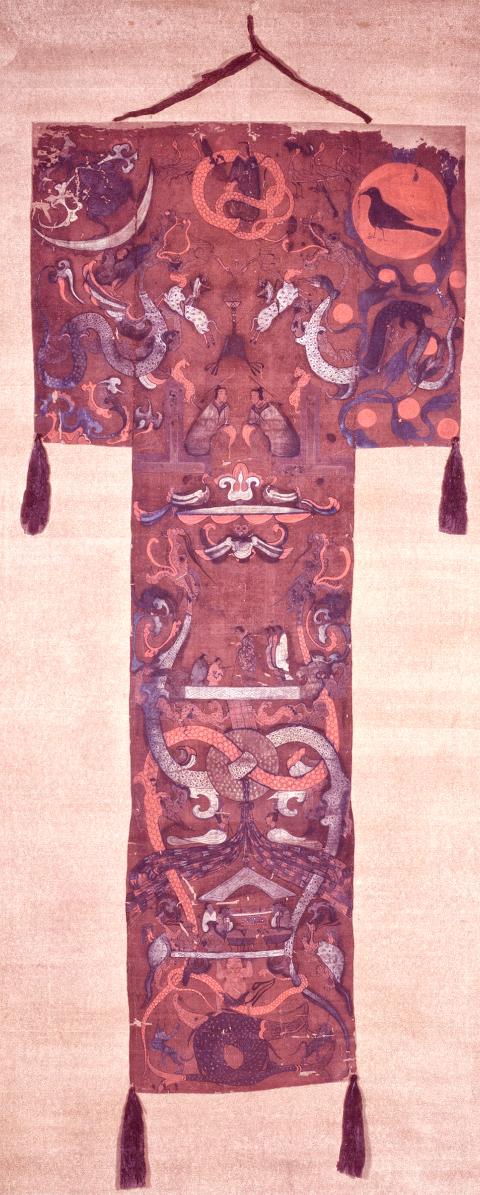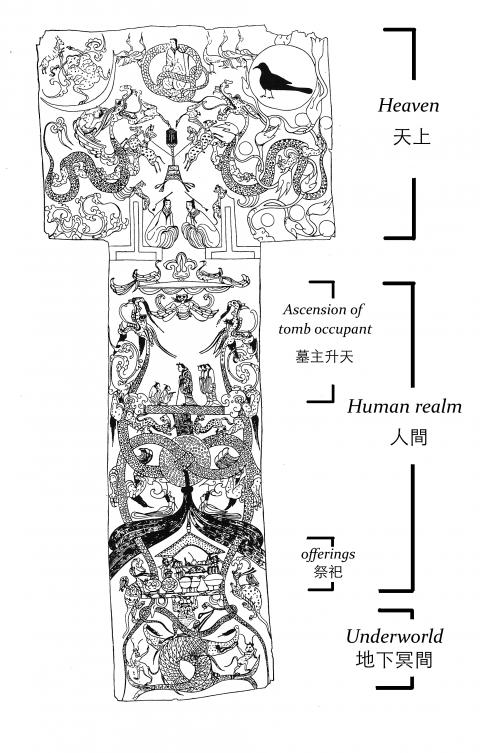The three Han Dynasty tombs excavated in 1972 at Mawangdui in Hunan’s Changsha was an extremely significant archaeological discovery. Tomb no. 1, in particular, found in a state of complete preservation, contained not only the perfectly mummified corpse of the tomb occupant Lady Dai — personal name Xin Zhui — but also a wealth of cultural artifacts. Among these, the most spectacular was an exquisite T-shaped silk banner.
The banner painting, on purplish-red dyed silk, was divided into three sections, depicting Heaven, the human realm and the Underworld. The horizontal top section represents Heaven, with a sun on the top right corner containing the Golden Crow and a moon to the top left with a toad. Between these sits a creature with a human head upon a serpent’s torso: the mythological creator of humans Nuwa (or Fuxi). At the base of this section sit two deities — thought to be a senior and junior judge of life — lying sentry to the entrance of Heaven.
The vertical section of the painting below this shows a noblewoman (Lady Dai) standing, with the aid of a cane, in the middle of a platform, accompanied by servants in front and behind her, as if preparing her for her ascension to Heaven.

Photo: Wikimedia Commons
照片:維基共享資源
A pair of dragons, intertwined through a ritual jade bi disc, serve as a divider between the platform above and a scene below of the woman’s descendants making offerings of delicacies. This scene is being supported from below by the mythical creature Gun, who is himself standing upon a pair of whales with interlocking tails.
The T-shaped banner was to be used in the “calling of the soul” ritual following a death. It would have been hung at the front of the funeral procession to guide the soul into the burial chamber, and from there on its journey to Heaven. Above and beyond this function, the banner is testament to the exquisite artistry of the time, and tells us much about the folk religion and world view of the period.
The painting as a whole uses heavenly bodies together with the symbols and iconography of the creation of the universe and mythological creatures to represent the cosmological order; its vertical composition not only portrays the structure of the world view, it also encapsulates a chronological narrative, reading almost like a comic strip.

Photo: Paul Cooper, Taipei Times
照片:台北時報古德謙
At the same time, the individual scenes are filled with profound decorative and symbolic meaning, with the jade bi discs, musical instruments such as the zhong bells and qing chime stones and the flowing lines of the four dragons — two in Heaven and another two interlocking dragons extending up from the Underworld into the human realm — hold the entire composition together. The banner is a perfect example of the linear beauty of traditional Chinese visual art.
(Translated by Paul Cooper)
一九七二年於湖南長沙馬王堆出土的三座漢墓,是極重要的考古發現,尤其是保存完整的一號墓,不但有墓主軑侯夫人辛追未腐化的身軀,還有豐富的文物藝品。其中最引人注目的,是一件精美的T形帛畫。
這幅在染成絳色絲絹上的彩繪,分成天上、人間、地底三個部分。置頂橫向畫面描繪的是天上:有右上方的太陽(金烏)、左上的月亮(蟾蜍),及中間人首蛇身的女媧(或伏羲);底下則有看守天界入口的兩位神祇(一般認為是大司命與少司命)。
以下垂直部分的畫幅,是一位貴婦(即軑侯夫人)拄杖站在一平台中央,前後有隨從服侍,似正準備升天。
在這之下以龍和玉璧交穿的圖樣做出分隔,再往下是子孫奉上山珍海味的祭祀場景。這祭祀場景,是由地底下的神話人物鯀所撐起,鯀腳底下踩著兩尾互相交錯的鯨鯢。
這T形幡是用來招魂的特定形式,出殯時懸掛在前,引導亡靈至墓中,然後升天。這件帛畫更讓我們一窺當時精美的工藝,以及民間的信仰與世界觀。
它整個畫面以日月星辰、創世神話人物、神獸等符號圖騰布局,鋪陳出宇宙的秩序;其上下分層及位置安排,不僅是世界觀的構築,也是時間上的敘事,如同連環漫畫的分鏡。
然而其「分鏡」,本身即深具裝飾性與圖騰意義,例如玉璧,和鐘、磬等樂器的運用,以及用四條龍(天上兩條,及貫穿人間與地底的兩條交纏的龍)的靈動線條,來羅織貫穿整個畫面構圖。咸認中國傳統視覺藝術是「線條」的藝術,由此可見。
(台北時報林俐凱)

In an effort to fight phone scams, British mobile phone company O2 has introduced Daisy, an AI designed to engage phone con artists in time-wasting conversations. Daisy is portrayed as a kindly British granny, exploiting scammers’ tendency to target the elderly. Her voice, based on a real grandmother’s for authenticity, adds to her credibility in the role. “O2” has distributed several dedicated phone numbers online to direct scammers to Daisy instead of actual customers. When Daisy receives a call, she translates the scammers’ spoken words into text and then responds to them accordingly through a text-to-speech system. Remarkably, Daisy

Bilingual Story is a fictionalized account. 雙語故事部分內容純屬虛構。 Emma had reviewed 41 resumes that morning. While the ATS screened out 288 unqualified, she screened for AI slop. She could spot it a mile away. She muttered AI buzzwords like curses under her breath. “Team player.” “Results-driven.” “Stakeholder alignment.” “Leveraging core competencies.” Each resume reeked of AI modeling: a cemetery of cliches, tombstones of personality. AI wasn’t just changing hiring. It was draining the humanity from it. Then she found it: a plain PDF cover letter. No template. No design flourishes. The first line read: “I once tried to automate my

Every May 1, Hawaii comes alive with Lei Day, a festival celebrating the rich culture and spirit of the islands. Initiated in 1927 by the poet Don Blanding, Lei Day began as a tribute to the Hawaiian custom of making and wearing leis. The idea was quickly adopted and officially recognized as a holiday in 1929, and leis have since become a symbol of local pride and cultural preservation. In Hawaiian culture, leis are more than decorative garlands made from flowers, shells or feathers. For Hawaiians, giving a lei is as natural as saying “aloha.” It shows love and

1. 他走出門,左右看一下,就過了馬路。 ˇ He walked outside, looked left and right, and crossed the road. χ He walked outside and looked left and right, crossed the road. 註︰並列連接詞 and 在這句中連接三個述語。一般的結構是 x, y, and z。x and y and z 是加強語氣的結構,x and y, z 則不可以。 2. 他們知道自己的弱點以及如何趕上其他競爭者。 ˇ They saw where their weak points lay and how they could catch up with the other competitors. χ They saw where their weak points lay and how to catch up with the other competitors. 註:and 一般連接同等成分,結構相等的單詞、片語或子句。誤句中 and 的前面是子句,後面是不定詞片語,不能用 and 連接,必須把不定詞片語改為子句,and 前後的結構才相等。 3. 她坐上計程車,直接到機場。 ˇ She took a cab, which took her straight to the airport. ˇ She took a cab and it took her straight